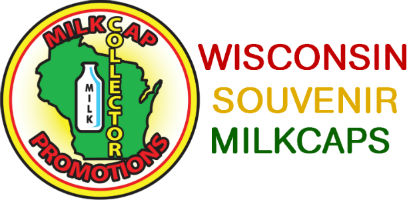Milkcaps have been around for much longer than you might have believed, and the various uses for them are equally as interesting. If you’ve ever wondered, “What’s a Milkcap?”, then you’ve come to the right place.
The facts about Milkcaps can be broken into various categories. The History of Milkcap, The Collectible Value of the Milkcap, and The Game played using them. Look below, and explore the area that interests you most.
History of the Milkcap
Milkcaps are round paperboard bottle-tops that many dairies used to include as the closure atop bottles of milk – some classic dairies still do! They were made of two layers of stiff board, with a flip-up pulltab, secured with a staple. It fit snugly in a groove on the inside of the bottle neck. The older waxed milkcaps are HIGHLY collectible.
Long before their use in dairies, the Japanese played a game called Menkos over 600 years ago. They used round playing pieces the same size as milkcaps, but they were made of clay, ceramic or wood, and had colorful images of classical Japanese icons such as Sumo wrestlers, Samurai warriors, and more.
The early 20th century Japanese immigrants who came to Hawaii brought this game with them, and from the early 1900s until the about the 1960s, bottled milk in the islands, and elsewhere, had a waxed top insert which kids used to basically to play the same game as Menkos.
In the 1980s, the Haleakala Dairy on the island of Maui introduced a new fruit drink called Passion Orange Guava juice, and advertised it on their milkcap inserts as POG. This led to the phenomenal popularity of the POG game in the mid-1980s and into the 1990s. There is even a published book that documents a Hawaiian teacher that would use milkcaps as flashcards to teach children mathematics.
Although the game is not played as often as it once was, the milkcaps (or pogs) themselves can be used in the game and hold collectible value for the more desired ones. Wisconsin Souvenir Milkcaps has brought back milkcaps for all to use or collect once again. Be a part of history and start your own collection today.
The Collectible Value of the Milkcap
The collectible value of milkcaps has been an interesting issue for well over a hundred years, however, some people erroneously equate the collectible value of milkcaps with the actual cost of manufacturing them. Therefore, a milkcap that cost ten cents to make is often seen as cheap, and cannot hold any collectible value.
Holding that same logic, would it mean that Leonardo da Vinci’s painting, the Mona Lisa, is only worth the cost of the canvas and paint used? Of course not – it clearly holds much more value. This holds true for all items that are deemed collectible.
Although not quite as famous of the Mona Lisa, there was a milkcap produced which clearly held a much greater value than the ten cents it took to manufacture it. This milkcap was called the Lexus Cap. It was produced during Hawaii’s milkcap frenzy and was a limited edition product. In order to acquire this Lexus Cap, one also had to purchase a Lexus Car – roughly valued at $60,000. Shortly after, the Lexus Cap appeared on the market with a selling price of $50 – $250, being 500 to 2500 times the cost to manufacture it. Yet even with this high price tag, people still traded the milkcap, due to the prestige associated with it – much like any collectible worth value.
Collectible value is dependant on many factors, but most importantly, a milkcap and its perceived value should be based on the enjoyment it gives you in owning it. This enjoyment could be from the art or image on it, or it could stand for something important to you – be it the history, prestige, sentiment, attitude, or art appreciation. When it comes to collectible items, the whole can be much more than the sum of its parts. So when you find something you really like, save it, and someday – it could be well worth your while.
Start Collecting your own Milkcaps!
The Game – Official Rules
The object of the game is to win as many caps as you can!
3 – Determine who goes first. Players then take turns one after the other.
4 – Each player uses what is called a Kini, slammer, or Hitter. A player’s turn is a throw of the Kini onto the top of the stack of caps. This throw is an attempt to flip as many caps over as possible.
5 – All caps that land blank side up (art side down) is that player’s winnings.
6 – All caps remaining art side up are restacked into a straight and even column once again.
7 – The next player’s turn then goes through steps 4-6.
8 – Players continue until the very last cap is won.



